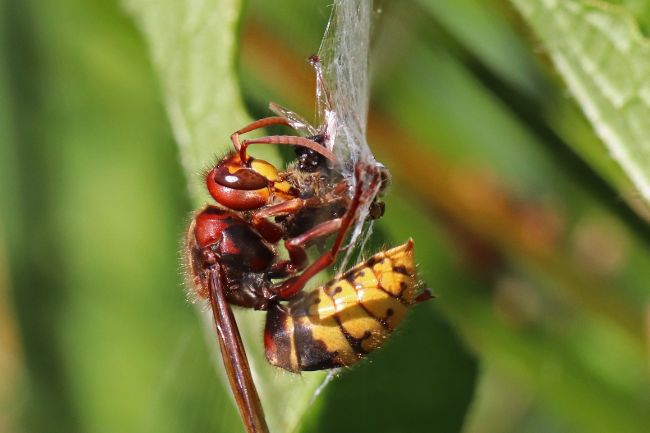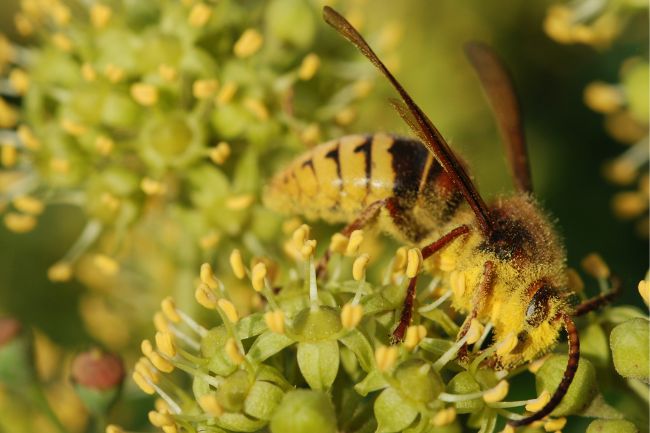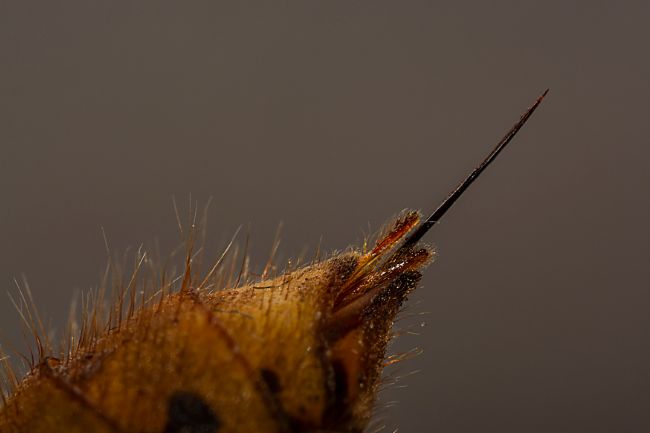Hornets are type of wasp and therefore carry all the negative associations of these misunderstood insects. Added to this hornets are often larger, with vicious looking stingers. It’s therefore not surprising that most people consider them to be a dangerous and unwelcome pest.
However, hornets don’t deserve their vicious reputation, largely ignoring humans unless threatened. As well as being relatively mild-mannered, hornets also have important ecological roles to play, from keeping other pest species in check, to helping dispose of waste.
Hornets Predation on Pest Insects
Hornets are efficient predators, and eat a large number of other insects and creepy-crawlies. During the spring and summer most hornets will be continuously heading out to pick up a tasty take-away.
With their handy wings and venomous stings they can take down species as big or larger than them, stinging their prey to paralyze or kill them, then returning to their nest with their prize.

Hornets aren’t fussy in what they eat and will take advantage of whatever they come across. Caterpillars, spiders and even dragonflies can end up as a hornet’s dinner if they aren’t careful.
Also read: What Eats Caterpillars? (A List of its Enemies)
Controlling Pest Populations and Maintaining Balance
As with many predators, their presence in our ecosystems can ensure that prey species numbers don’t get out of control. This can be particularly important for species that act as agricultural pests, where large numbers can damage crops.
Because they don’t target particular species, hornets are more likely to predate anything that is common, allowing struggling species to recover and knocking back those that have started to take over.
Carrion Disposal and Nutrient Cycling
As well as actively hunting for food, hornets will also spend part of the year foraging for easy leftovers. Dead animals, rotting fruit and even food waste, are all welcome additions to their diets. These easy pickings tend to be what they look for during autumn, when cooler weather, and less food availability means they want an easy meal rather than expending energy on hunting.

By feeding on carrion and decomposing plant matter, hornets help to get rid of potentially harmful waste. Rotting bodies and food, can cause a spread of disease. By gobbling up whatever they can, they help reduce the chance of these diseases spreading.
As well as reducing the likelihood of disease spreading, feeding on this waste helps to break it down. As the hornets digest and excrete whatever they’ve eaten, they make the nutrients within it much more available for plants, helping to cycle nutrients through the natural environment.
Also read: How & What do Cicadas Eat? (Eating Habits Explained)
Hornet Pollination vs. Other Pollinator Species
| Pollinator Species | Pollination Effectiveness | Primary Pollen Carriers | Floral Preferences |
|---|---|---|---|
| Honeybees | Highly effective | Body and leg hairs | Flowers with sweet nectar |
| Bumblebees | Efficient pollinators | Hairy bodies | Wide range of flowering plants |
| Butterflies | Variable effectiveness | Long proboscis | Brightly colored, scented flowers |
| Hornets | Surprisingly effective | Hairy bodies | Various flowering plants |
| Birds (e.g., hummingbirds) | Effective for certain flowers | Long bills and tongues | Tubular, red or orange flowers |
While bees get all the credit as pollinators, there are actually a wide range of animals that carry out this role. Hornets are some of the less known pollinators, travelling to flowers to feed on pollen and nectar, and then transferring some of that pollen to other flowers, helping to pollinate them.
Like many pollinators, hornets aren’t hugely fussy about what flowers they visit. Mostly they will simply be close to where the hornet is hunting or foraging. Flowers like ivy, thistles and daisies can all potentially be visited.
One of the reasons bees are such good pollinators is that they are covered in fur, that helps pick up and trap the pollen. Wasps and hornets are less hairy, and therefore tend to trap less pollen. They also visit less flowers than bees do, so have less of a chance to spread pollen between plants.

Also read: Do Bees Eat Pollen? What & How Often do They Actually Eat?
How Hornets Fit into Nature’s Food Chain
Hornets are predators, and will sit above most insects and creepy-crawlies in the food web. However, they are also preyed on themselves, and will be eaten by some birds and mammals.
Their Nesting Behaviours
Hornets are eusocial, living in nests with others that are closely related. Like bees, hornets have a queen, who starts building the nest and lays the first eggs to create her initial workforce. Once these workers have hatched, they will continue to build the nest and raise the next generation.
The nest will thrive throughout the summer and into the autumn, but come winter the inhabitants will have died, only the young queens surviving to ground a nest the following year.

Also read: What Happens with Hornets in Winter?
Dealing with Hornets
Hornets are relatively uninterested in humans most of the time, however they will attack if they or their nest are threatened. Usually this happens if they nest somewhere humans need to access, such as within an attic.
While there may be occasions when nests need to be destroyed, this should always be the last resort. With the nests inhabitants dying off in the winter, it will be safe to dispose of at that point. In the meantime the area they are nesting in should be avoided.
Hornet Stings and Safety Precautions
| Action | Description |
|---|---|
| Wash the Sting Site | Clean the affected area with soap and water to reduce the risk of infection. |
| Remove Stinger | Use a credit card or similar object to scrape away the stinger without squeezing it. |
| Apply Cold Compress | Apply a cold pack or clean cloth with cold water to reduce pain and swelling. |
| Pain Relief | Over-the-counter pain relievers like ibuprofen or acetaminophen may help alleviate discomfort. |
| Seek Medical Attention | If allergic reactions occur, such as difficulty breathing or severe swelling, seek immediate medical help. |
Hornet stings are largely not dangerous to humans unless they are allergic. In most cases it will cause mild discomfort that will fade over time. Being stung by a large number of hornets at once can however be dangerous, as the body reacts to the large amount of poison being administered.
If a nest needs to be removed it’s always best to contact a professional, as hornets will attack those that they see as a threat to their home.

Also read: What to do if You’re Stung by a Bee (& How to Get Sting Out)?
Conclusion
As with all animals their importance and impact on the nature environment can’t be underestimated. From controlling pests to pollinating plants, to acting as natural recyclers, their place within our ecosystem should be respected.
It’s often easy to villainize those animals who aren’t of obvious use to us, however, each creature has its place, and we remove them at our own peril.

